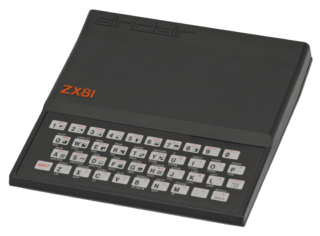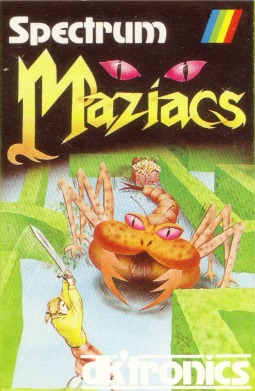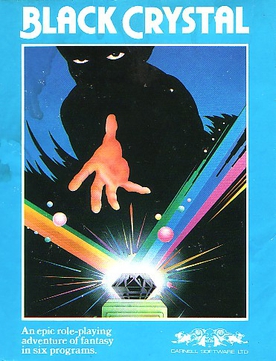
The ZX Spectrum is an 8-bit home computer developed and marketed by Sinclair Research. It is one of the most influential computers ever made, and also one of the best selling computers ever, with over five million units sold. It was first released in the United Kingdom on 23 April 1982, and around the world in the following years, most notably in Europe, the United States, and Eastern Bloc countries.

The ZX81 is a home computer that was produced by Sinclair Research and manufactured in Dundee, Scotland, by Timex Corporation. It was launched in the United Kingdom in March 1981 as the successor to Sinclair's ZX80 and designed to be a low-cost introduction to home computing for the general public. It was hugely successful; more than 1.5 million units were sold. In the United States it was initially sold as the ZX-81 under licence by Timex. Timex later produced its own versions of the ZX81: the Timex Sinclair 1000 and Timex Sinclair 1500. Unauthorized ZX81 clones were produced in several countries.

3D Monster Maze is a survival horror computer game developed from an idea by J.K. Greye and programmed by Malcolm Evans and released in 1981 for the Sinclair ZX81 platform with the 16 KB memory expansion. The game was initially released by J. K. Greye Software in December 1981 and re-released in 1982 by Evans' own startup, New Generation Software. Rendered using low-resolution character block "graphics", it was one of the first 3D games for a home computer, and one of the first games incorporating typical elements of the genre that would later be termed survival horror.

CRL Group plc was a British video game development and publishing company. Originally CRL stood for "Computer Rentals Limited". It was based in King's Yard, London and run by Clem Chambers.
Vortex Software was a video game developer founded by Costa Panayi and Paul Canter in the early 1980s to sell the game Cosmos which Panayi had developed for the Sinclair ZX81. They converted the game to the ZX Spectrum, but due to the low sales of the ZX81 version they licensed the game to Abbex.

Artic Computing was a software development company based in Brandesburton, England from 1980 to 1986. The company's first games were for the Sinclair ZX81 home computer, but they expanded and were also responsible for various ZX Spectrum, Commodore 64, BBC Micro, Acorn Electron and Amstrad CPC computer games. The company was set up by Richard Turner and Chris Thornton. Charles Cecil, who later founded Revolution Software, joined the company shortly after it was founded, writing Adventures B through D. Developer Jon Ritman produced a number of ZX81 and Spectrum games for Artic before moving to Ocean Software.

New Generation Software was an early British video games developer producing games for the Sinclair ZX81 and ZX Spectrum computers. It was conceived in the spring of 1982 shortly after the lead developer, Malcolm Evans created 3D Monster Maze —one of the first 3D games for a home computer.
J.K. Greye Software was a British software company set up by J.K. Greye in early 1981 and 6 months later joined by Malcolm Evans after they met at a Bath Classical Guitar & Lute Society meeting in Bath in 1981. They produced computer games for the Sinclair ZX81 and ZX Spectrum home computers.

Trashman is a video game developed by Malcolm Evans for the ZX Spectrum and released by New Generation Software in 1984.
Quicksilva was a British games software publisher active during the early 1980s.
Costa Panayi is a former computer game programmer active during the 1980s. He founded Vortex Software with Paul Canter, publishing games for the ZX Spectrum, Commodore 64 and Amstrad CPC.
DK'Tronics Ltd was a British software and hardware company active during the 1980s. It primarily made peripherals for the ZX Spectrum and Amstrad CPC but also released video games for the ZX81, ZX Spectrum, Commodore 64, VIC-20, BBC Micro, Memotech MTX, MSX and Amstrad platforms.

Maziacs is an action adventure maze game published by DK'Tronics in 1983 for the ZX Spectrum, Commodore 64, and MSX.
Don Priestley is a teacher and former video game programmer who wrote over 20 commercial games for the ZX81 and ZX Spectrum home computers between 1982 and 1989. Despite successful releases for DK'Tronics, such as 3D Tanx and Maziacs, Priestley returned to teaching in the late 1980s, claiming changes in the video game industry did not suit his style of work.

3D Tunnel is a shoot 'em up video game written by Malcolm Evans for the ZX Spectrum It was published by New Generation Software in 1983.

Escape is maze video game for the ZX Spectrum developed by New Generation Software and published in 1982.
Richard Shepherd Software was a British software house active between 1982 and 1985. The company was mainly known for releasing text adventure games. These were programmed by Richard Shepherd himself and Pete Cooke.
Knot in 3D is a ZX Spectrum action game by Malcolm Evans published in 1983 by New Generation Software. It resembles a three-dimensional version of the Light cycles game from the film Tron.

Black Crystal is an action-adventure game released in 1982 for the ZX81, ZX Spectrum, Commodore 64 and TI-99/4A computers by Carnell Software Ltd. It was the first in the "Third Continent Trilogy" of adventure games; followed by Volcanic Dungeon and The Wrath of Magra.











